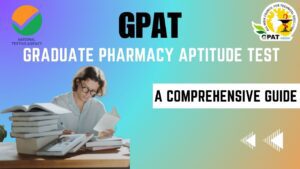GPAT (Graduate Pharmacy Aptitude Test): A Comprehensive Guide

Graduate Pharmacy Aptitude Test (GPAT):
The Graduate Pharmacy Aptitude Test (GPAT) is a national-level entrance examination conducted in India for admission to postgraduate pharmacy programs, such as M.Pharm.
GPAT is regulated by the National Testing Agency (NTA) and serves as a gateway for aspiring pharmacy graduates to pursue higher education and build a career in the pharmaceutical industry.
In this blog, we will delve into the essential aspects of GPAT, including cutoff, merit list, dates, pattern, and syllabus.
GPAT Cutoff:
The GPAT cutoff refers to the minimum score or rank required by candidates to qualify for admission to various pharmacy institutes.
The cutoff marks are determined based on several factors, including the number of test-takers, the difficulty level of the exam, and the availability of seats.
Each participating institute sets its own cutoff scores, which may vary from year to year.
It is crucial for candidates to achieve a score above the cutoff to secure admission in their preferred institutions.
The GPAT cutoff is generally announced after the declaration of results.
Candidates who meet the cutoff criteria are eligible for counseling or further selection processes.
It is important to note that different institutes may have different cutoff scores, depending on factors like the reputation of the institution and the competition level among applicants.
GPAT Merit List:
The merit list is prepared based on the performance of candidates in the GPAT examination.
It contains the names of candidates in descending order of their scores or ranks.
The merit list serves as a crucial reference for institutions during the admission process.
Candidates with higher ranks have a better chance of securing admission to their desired pharmacy colleges.
After the release of the GPAT results, the merit list is published by the conducting authority.
It provides an overview of the top-performing candidates and helps institutions streamline their admission procedures.
While the merit list plays a significant role in the selection process, it is essential to remember that each participating institute may have its own criteria for selecting candidates from the merit list, such as counseling or personal interviews.
GPAT Important Dates:
The GPAT examination is usually held once a year, and the NTA releases a detailed schedule well in advance.
Being aware of the important dates associated with GPAT is crucial for candidates to plan their preparation effectively.
While the dates may vary slightly each year, the general timeline is as follows:
– Release of GPAT notification: November/December
– Start of GPAT registration: December
– Last date for GPAT registration: January
– Availability of GPAT admit card: January
– GPAT examination date: January/February
– Announcement of GPAT results: February/March
Candidates are advised to regularly check the official website of the NTA or the GPAT portal for updates regarding the examination dates and other related information.
GPAT Exam Pattern:
Understanding the exam pattern is essential for candidates to familiarize themselves with the structure and nature of the GPAT examination. By knowing the pattern, candidates can plan their preparation accordingly and allocate time to each section.
The GPAT exam follows a consistent pattern each year. Here are the key features of the GPAT exam pattern:
– Mode of Examination: Computer-based Test (CBT)
– Duration: 180 minutes (3 hours)
– Number of Questions: 125
– Question Type: Multiple Choice Questions (MCQs)
– Marking Scheme: +4 marks for each correct answer, -1 mark for each incorrect answer
– Sections: The exam comprises four sections: Pharmaceutical Chemistry, Pharmacology, Pharmaceutics, and Pharmacognosy. Each section carries an equal weightage.
Candidates should focus on all the sections and allocate their time based on their strengths and weaknesses.
Practicing previous year’s question papers and taking mock tests can help in understanding the exam pattern and managing time effectively during the actual examination.
GPAT Syllabus:
To excel in the GPAT exam, candidates must be well-versed in the syllabus. The syllabus covers various subjects related to pharmacy and pharmaceutical sciences. Here are the key topics included in the GPAT syllabus:
– Physical Chemistry: States of Matter, Thermodynamics, Equilibrium, Chemical Kinetics, Electrochemistry, etc.
– Organic Chemistry: Basic Principles, Nomenclature, Isomerism, Reaction Mechanisms, Biomolecules, Polymers, etc.
– Inorganic Chemistry: Periodic Table, Chemical Bonding, Coordination Compounds, Main Group Elements, Transition Metals, etc.
– Pharmacology: General Pharmacology, Autonomic Nervous System, Central Nervous System, Cardiovascular System, Drug Metabolism, etc.
– Pharmaceutics: Introduction to Pharmacy, Physical Pharmacy, Pharmaceutical Engineering, Dosage Forms, Pharmaceutical Technology, etc.
– Pharmaceutical Analysis: Fundamentals of Analysis, Pharmaceutical Impurities, Instrumental Methods, Quality Assurance, etc.
– Pharmaceutical Jurisprudence: Legal Aspects of Pharmacy, Pharmacy Act, Drug and Magic Remedies Act, Drug Price Control Orders, etc.
– Pharmaceutical Engineering: Fluid Flow, Heat Transfer, Mass Transfer, Filtration, Distillation, Evaporation, etc.
– Pharmacognosy: Sources of Drugs, Classification of Drugs, Phytochemistry, Herbal Drug Technology, Plant Tissue Culture, etc.
– Biotechnology: Recombinant DNA Technology, Fermentation Technology, Enzyme Technology, Bioprocess Engineering, etc.
– Microbiology: Microbial Classification, Microbial Growth, Sterilization, Disinfection, Microbial Assay, etc.
– Biochemistry: Biomolecules, Enzymes, Metabolism, Vitamins, Minerals, Biochemical Techniques, etc.
Conclusion:
The GPAT (Graduate Pharmacy Aptitude Test) is a crucial examination for pharmacy graduates seeking admission to postgraduate programs.
By understanding the cutoff, merit list, dates, pattern, and syllabus associated with GPAT, candidates can enhance their preparation and increase their chances of securing admission to reputed pharmacy colleges.
Hard work, perseverance, and a thorough understanding of the syllabus will help aspiring pharmacists achieve their academic goals through GPAT. Good luck to all the candidates!
Also, Visit: Cracking the DHA Pharmacist Exam: Your Ultimate Syllabus Roadmap for Success in Dubai’s Pharmacy World
Mastering the DHA Pharma Exam: Your Path to Pharmacist Success in Dubai’s Healthcare Landscape
B. Pharma and D. Pharma Notes, MCQS, Question Books, Lab Manuals